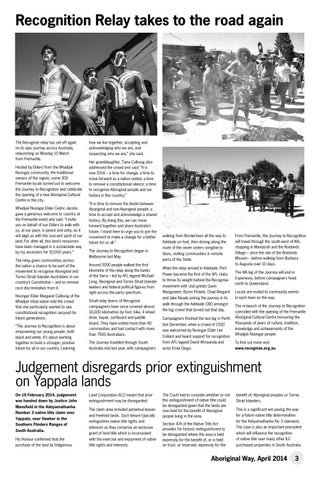Recognition Relay takes to the road again
The Recognise relay has set off again on its epic journey across Australia, relaunching on Monday 10 March from Fremantle. Hosted by Elders from the Whadjuk Noongar community, the traditional owners of the region, some 300 Fremantle locals turned out to welcome the Journey to Recognition and celebrate the opening of a new Aboriginal Cultural Centre in the city. Whadjuk Noongar Elder Cedric Jacobs gave a generous welcome to country at the Fremantle event and said: “I invite you on behalf of our Elders to walk with us, at our pace, in peace and unity, as it will align us with the soul and spirit of our land. For after all, this land’s resources have been managed in a sustainable way by my ancestors for 50,000 years.” The relay gives communities across the nation a chance to be part of the movement to recognise Aboriginal and Torres Strait Islander Australians in our country’s Constitution – and to remove race discrimination from it. Noongar Elder Margaret Culbong of the Whadjuk tribal nation told the crowd that she particularly wanted to see constitutional recognition secured for future generations. “The Journey to Recognition is about empowering our young people, both black and white, it’s about working together to build a stronger, positive future for all in our country. Learning
how we live together, accepting and acknowledging who we are, and respecting who we are,” she said. Her granddaughter, Tiana Culbong also addressed the crowd and said: “It is now 2014 – a time for change; a time to move forward as a nation united; a time to remove a constitutional silence; a time to recognise Aboriginal people and our history in this country.” “It is time to remove the divide between Aboriginal and non-Aboriginal people; a time to accept and acknowledge a shared history. By doing this, we can move forward together and share Australia’s future. I stand here to urge you to join the movement to make a change for a better future for us all.” The Journey to Recognition began in Melbourne last May. Around 2000 people walked the first kilometre of the relay along the banks of the Yarra – led by AFL legend Michael Long, Aboriginal and Torres Strait Islander leaders and federal political figures from right across the party spectrum. Small relay teams of Recognise campaigners have since covered almost 16,000 kilometres by foot, bike, 4 wheel drive, kayak, surfboard and paddle board. They have visited more than 90 communities and had contact with more than 7500 Australians. The Journey travelled through South Australia mid last year, with campaigners
walking from Bordertown all the way to Adelaide on foot, then driving along the route of the seven sisters songline to Uluru, visiting communities in remote parts of the State. When the relay arrived in Adelaide, Port Power became the first of the AFL clubs to throw its weight behind the Recognise movement with club greats Gavin Wanganeen, Byron Pickett, Chad Wingard and Jake Neade joining the journey in its walk through the Adelaide CBD amongst the big crowd that turned out that day. Campaigners finished the last leg in Perth last December, when a crowd of 1500 was welcomed by Noongar Elder Len Collard and heard support for recognition from AFL legend David Wirrpanda and actor Ernie Dingo.
From Fremantle, the Journey to Recognition will travel through the south-west of WA, stopping in Mandurah and the Roelands Village – once the site of the Roelands Mission – before walking from Bunbury to Augusta over 10 days. The WA leg of the Journey will end in Esperance, before campaigners head north to Queensland. Locals are invited to community events in each town on the way. The re-launch of the Journey to Recognition coincided with the opening of the Fremantle Aboriginal Cultural Centre honouring the thousands of years of culture, tradition, knowledge and achievements of the Whadjuk Noongar people. To find out more visit www.recognise.org.au
Judgement disregards prior extinguishment on Yappala lands On 19 February 2014, judgement
Land Corporation (ILC) meant that prior
was handed down by Justice John
extinguishment may be disregarded.
Mansfield in the Adnyamathanha Number 3 native title claim over Yappala, near Hawker in the Southern Flinders Ranges of South Australia.
The claim area included perpetual leases and freehold lands. Such tenure typically extinguishes native title rights and interests as they comprise an exclusive grant of land title which is inconsistent
His Honour confirmed that the
with the exercise and enjoyment of native
purchase of the land by Indigenous
title rights and interests.
The Court had to consider whether or not this extinguishment of native title could be disregarded given that the lands are now held for the benefit of Aboriginal people living in the area. Section 47A of the Native Title Act provides for historic extinguishment to be disregarded where the area is held expressly for the benefit of, or is held on trust, or reserved, expressly for the
benefit of, Aboriginal peoples or Torres Strait Islanders. This is a significant win paving the way for a future native title determination for the Adnyamathanha No 3 claimants. The case is also an important precedent which will influence the recognition of native title over many other ILC purchased properties in South Australia.
Aboriginal Way, April 2014
3


